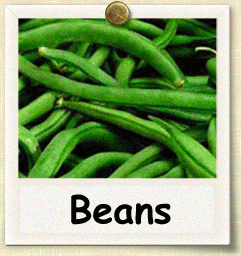|
Seeds > Heirloom > Legumes > Bean |
|
Heirloom Bean Seed |
|
|
| |
 |
|
Overview |
|
|
|
|
|
| |
|
| |
Gardeners generally divide bean varieties into three main categories, depending on the stage at which they're usually picked and eaten: snap, shell and dry. All are easy to grow, and all need the same growing conditions - the prime one being plenty of warmth.
Often called green beans or string beans, the common garden bean can be both stringless and colors other than green. But it’s the green bean that everyone recognizes as one of the most frequently prepared vegetables. Hot, cold, even raw, string beans are versatile in the kitchen and very prolific producers in the garden. |
|
| |
|
|
| |
Growing Guide
GROWING NOTES
Beans are generally direct seeded in the garden. The most important point
about growing green beans is not to plant them too early. They will rot in
cool, damp soil. To get an earlier start, you can put down black plastic, to
warm the soil.
Bush beans begin producing before pole beans and often come in all at
once. Staggered planting, every 2 weeks, will keep your bush beans going
longer. Pole beans need time to grow their vines, before they start setting
beans. The pole bean crop will continue to produce for a month or two.
Beans like a moderately rich soil with a slightly acidic pH of about 6.0 to 6.2.
They prefer a loose, moist soil. Plant after all danger of frost is past.
Plant bush beans in either rows or blocks, with 4-6 inches between each seed. Plant the seeds 1-2 inches deep and be
sure to water the soil immediately and regularly, until it sprouts.
Pole beans will need some type of support to grow on. Be sure the trellis, teepee, fence or whatever is in place before
you seed. Plant seeds at a rate of about 6-8 seeds per teepee or every 6 inches apart.
MAINTAINING BEANS
Pole beans may need some initial help in climbing. Keep the bean plants well watered. Mulch helps keep their shallow
roots moist. Long producing pole beans will benefit from a feeding or a side dressing of compost or manure about
half way through their growing season.
|
|
| |
|
| |
|
|
| |
|
|
| |
Harvesting Guide
HARVESTING
Harvesting beans is an ongoing process. You can start to harvest anytime,
but gardeners usually wait until the beans begin to firm up and can be snapped. They are generally about as think as a pencil then. Don’t wait too long, because beans can become overgrown and tough almost overnight. Harvest by gently pulling each bean from the vine or by snapping off the
vine end, if you are going to be using the beans right away.
SAVING SEEDS
I suggest that you earmark a couple of plants at the beginning of the season for seed saving. Don’t pick ANY pods from them to eat - just pick the crisp brown pods at the end of the season. Don’t feed them, or water them unless it is very dry - as this can encourage leafy growth rather than pod development. There is no point in picking green pods as the seeds are not mature enough at this stage.
Did you know you can save the roots, overwinter in a frost-free place, and replant next year? Runner beans are perennial, but are frost sensitive, so die back in our climate. However, if the roots are dug up and kept in suitable conditions, the plants often get away early and crop faster. If you grow a lot of beans, this may not be a practical option, but you could try it with one or two plants perhaps. Store the roots in a frost-free place, buried in slightly moist sand or leafmould, or something similar.
|
|
| |
|
|
|
| |
|
|